Consent in Healthcare: Legal Requirements and Practical Application
VerifiedAdded on 2023/06/13
|5
|1366
|408
Essay
AI Summary
This essay delves into the legal aspects of consent within healthcare, emphasizing its role as a cornerstone of ethical medical practice. It highlights the importance of voluntary, informed, and capacitous consent from patients before any medical examination or treatment, referencing the Nursing and Midwifery Council (NMC) code. The essay distinguishes between written, verbal, and implied consent, explaining their applications and the necessity of proper documentation. It also addresses the exception of implied consent in emergency situations where immediate life-saving measures are required. A personal experience is shared, illustrating the practical application and importance of obtaining written consent before a laparoscopic surgery, reinforcing the significance of respecting patient autonomy and adhering to legal standards in healthcare. The essay concludes by advocating for healthcare professionals to prioritize the consent process to ensure ethical and legally sound practices.
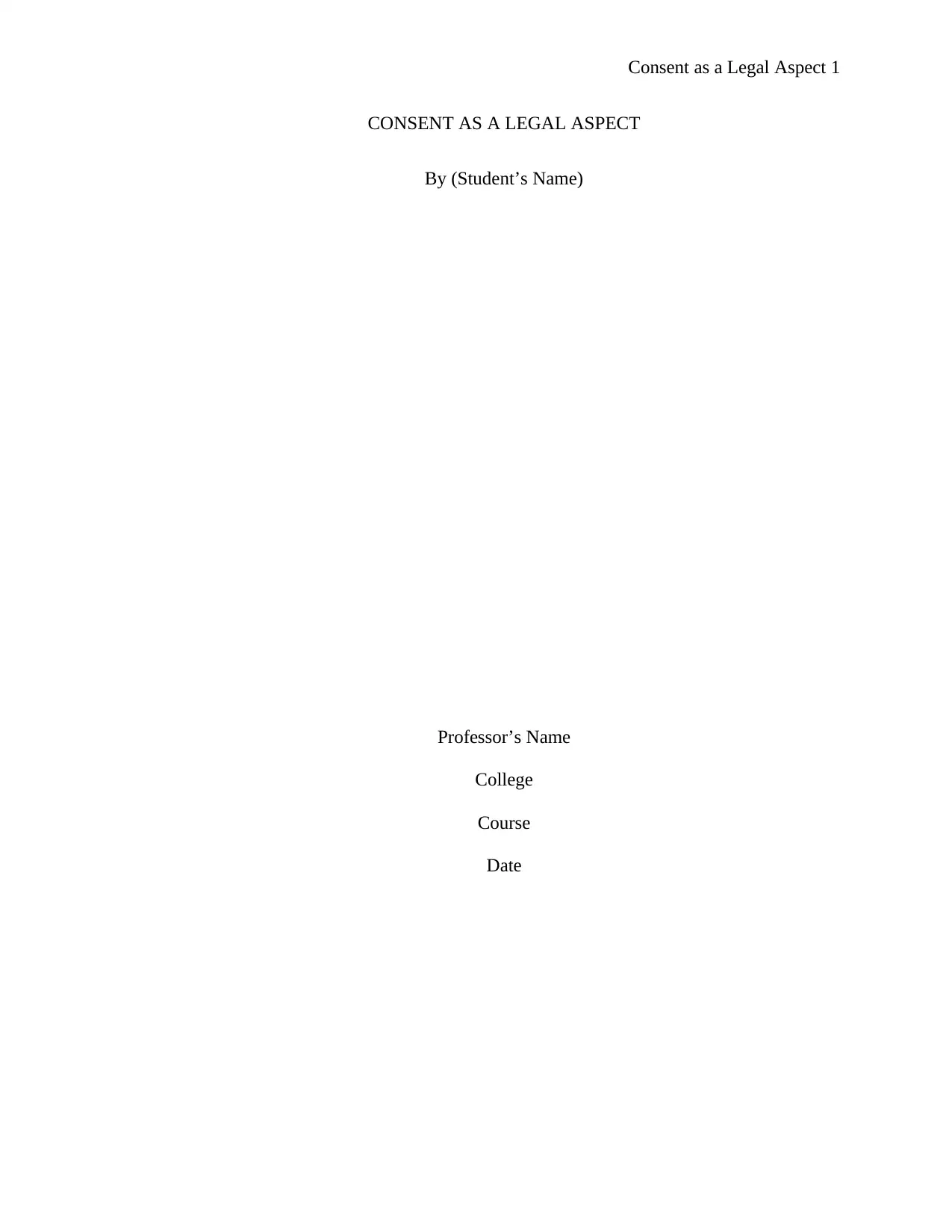
Consent as a Legal Aspect 1
CONSENT AS A LEGAL ASPECT
By (Student’s Name)
Professor’s Name
College
Course
Date
CONSENT AS A LEGAL ASPECT
By (Student’s Name)
Professor’s Name
College
Course
Date
Paraphrase This Document
Need a fresh take? Get an instant paraphrase of this document with our AI Paraphraser
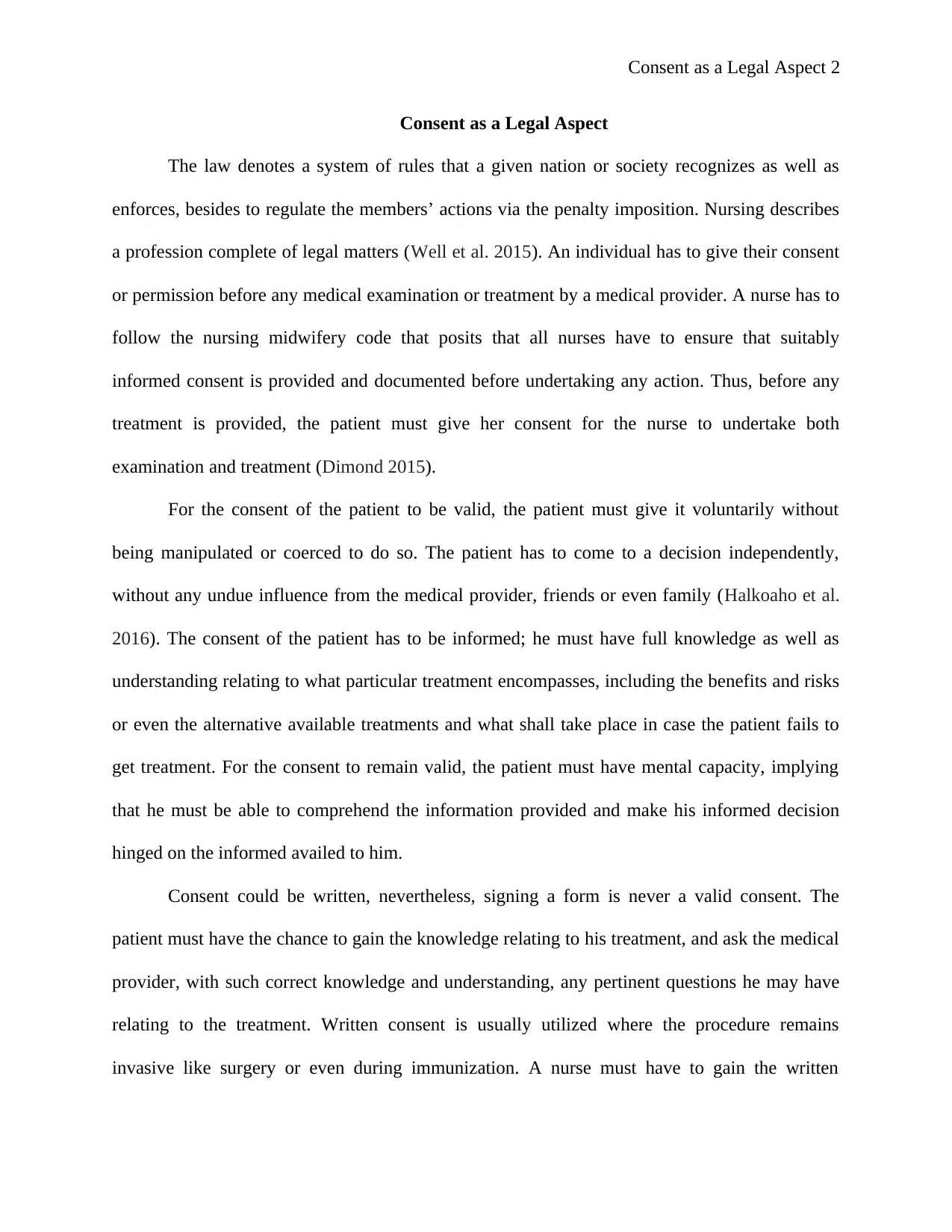
Consent as a Legal Aspect 2
Consent as a Legal Aspect
The law denotes a system of rules that a given nation or society recognizes as well as
enforces, besides to regulate the members’ actions via the penalty imposition. Nursing describes
a profession complete of legal matters (Well et al. 2015). An individual has to give their consent
or permission before any medical examination or treatment by a medical provider. A nurse has to
follow the nursing midwifery code that posits that all nurses have to ensure that suitably
informed consent is provided and documented before undertaking any action. Thus, before any
treatment is provided, the patient must give her consent for the nurse to undertake both
examination and treatment (Dimond 2015).
For the consent of the patient to be valid, the patient must give it voluntarily without
being manipulated or coerced to do so. The patient has to come to a decision independently,
without any undue influence from the medical provider, friends or even family (Halkoaho et al.
2016). The consent of the patient has to be informed; he must have full knowledge as well as
understanding relating to what particular treatment encompasses, including the benefits and risks
or even the alternative available treatments and what shall take place in case the patient fails to
get treatment. For the consent to remain valid, the patient must have mental capacity, implying
that he must be able to comprehend the information provided and make his informed decision
hinged on the informed availed to him.
Consent could be written, nevertheless, signing a form is never a valid consent. The
patient must have the chance to gain the knowledge relating to his treatment, and ask the medical
provider, with such correct knowledge and understanding, any pertinent questions he may have
relating to the treatment. Written consent is usually utilized where the procedure remains
invasive like surgery or even during immunization. A nurse must have to gain the written
Consent as a Legal Aspect
The law denotes a system of rules that a given nation or society recognizes as well as
enforces, besides to regulate the members’ actions via the penalty imposition. Nursing describes
a profession complete of legal matters (Well et al. 2015). An individual has to give their consent
or permission before any medical examination or treatment by a medical provider. A nurse has to
follow the nursing midwifery code that posits that all nurses have to ensure that suitably
informed consent is provided and documented before undertaking any action. Thus, before any
treatment is provided, the patient must give her consent for the nurse to undertake both
examination and treatment (Dimond 2015).
For the consent of the patient to be valid, the patient must give it voluntarily without
being manipulated or coerced to do so. The patient has to come to a decision independently,
without any undue influence from the medical provider, friends or even family (Halkoaho et al.
2016). The consent of the patient has to be informed; he must have full knowledge as well as
understanding relating to what particular treatment encompasses, including the benefits and risks
or even the alternative available treatments and what shall take place in case the patient fails to
get treatment. For the consent to remain valid, the patient must have mental capacity, implying
that he must be able to comprehend the information provided and make his informed decision
hinged on the informed availed to him.
Consent could be written, nevertheless, signing a form is never a valid consent. The
patient must have the chance to gain the knowledge relating to his treatment, and ask the medical
provider, with such correct knowledge and understanding, any pertinent questions he may have
relating to the treatment. Written consent is usually utilized where the procedure remains
invasive like surgery or even during immunization. A nurse must have to gain the written
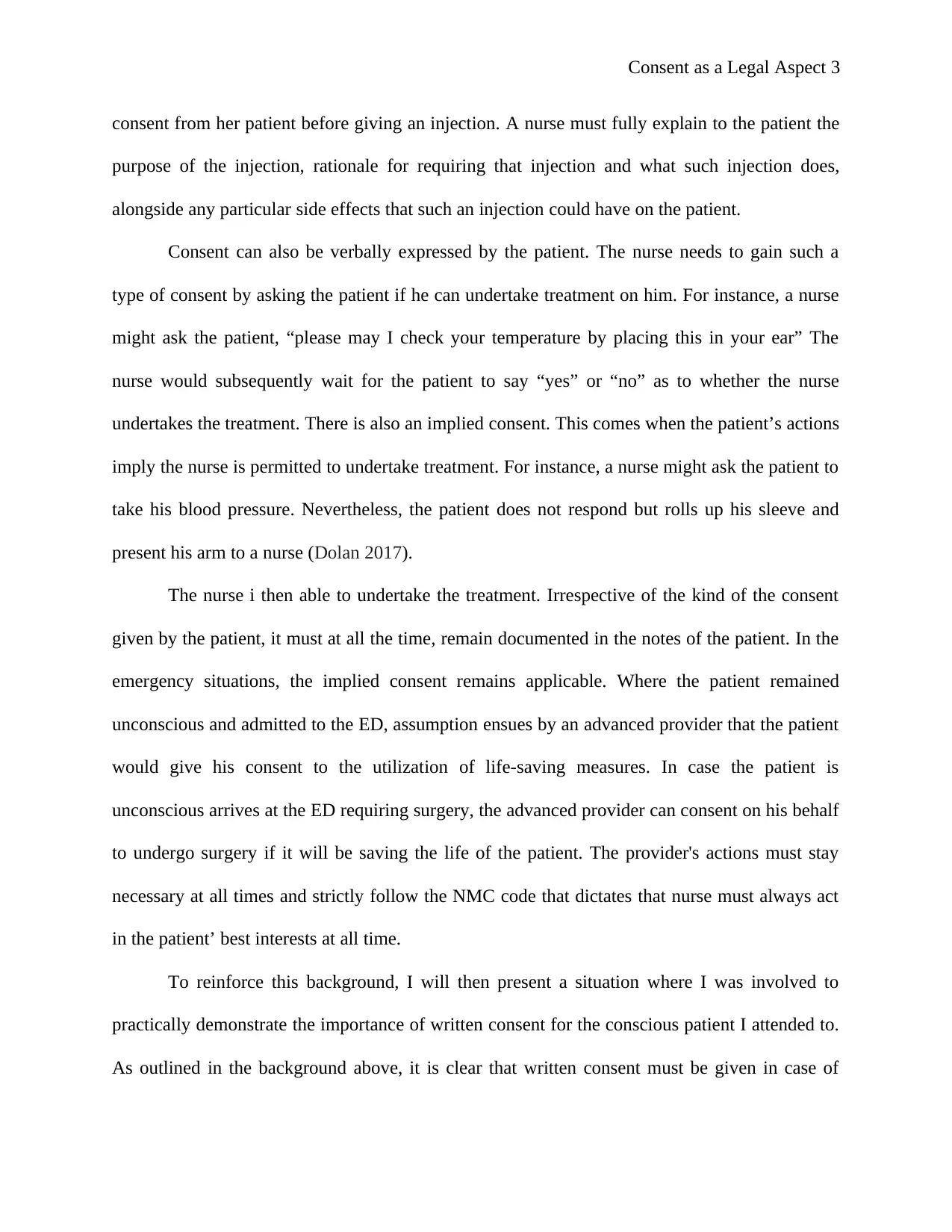
Consent as a Legal Aspect 3
consent from her patient before giving an injection. A nurse must fully explain to the patient the
purpose of the injection, rationale for requiring that injection and what such injection does,
alongside any particular side effects that such an injection could have on the patient.
Consent can also be verbally expressed by the patient. The nurse needs to gain such a
type of consent by asking the patient if he can undertake treatment on him. For instance, a nurse
might ask the patient, “please may I check your temperature by placing this in your ear” The
nurse would subsequently wait for the patient to say “yes” or “no” as to whether the nurse
undertakes the treatment. There is also an implied consent. This comes when the patient’s actions
imply the nurse is permitted to undertake treatment. For instance, a nurse might ask the patient to
take his blood pressure. Nevertheless, the patient does not respond but rolls up his sleeve and
present his arm to a nurse (Dolan 2017).
The nurse i then able to undertake the treatment. Irrespective of the kind of the consent
given by the patient, it must at all the time, remain documented in the notes of the patient. In the
emergency situations, the implied consent remains applicable. Where the patient remained
unconscious and admitted to the ED, assumption ensues by an advanced provider that the patient
would give his consent to the utilization of life-saving measures. In case the patient is
unconscious arrives at the ED requiring surgery, the advanced provider can consent on his behalf
to undergo surgery if it will be saving the life of the patient. The provider's actions must stay
necessary at all times and strictly follow the NMC code that dictates that nurse must always act
in the patient’ best interests at all time.
To reinforce this background, I will then present a situation where I was involved to
practically demonstrate the importance of written consent for the conscious patient I attended to.
As outlined in the background above, it is clear that written consent must be given in case of
consent from her patient before giving an injection. A nurse must fully explain to the patient the
purpose of the injection, rationale for requiring that injection and what such injection does,
alongside any particular side effects that such an injection could have on the patient.
Consent can also be verbally expressed by the patient. The nurse needs to gain such a
type of consent by asking the patient if he can undertake treatment on him. For instance, a nurse
might ask the patient, “please may I check your temperature by placing this in your ear” The
nurse would subsequently wait for the patient to say “yes” or “no” as to whether the nurse
undertakes the treatment. There is also an implied consent. This comes when the patient’s actions
imply the nurse is permitted to undertake treatment. For instance, a nurse might ask the patient to
take his blood pressure. Nevertheless, the patient does not respond but rolls up his sleeve and
present his arm to a nurse (Dolan 2017).
The nurse i then able to undertake the treatment. Irrespective of the kind of the consent
given by the patient, it must at all the time, remain documented in the notes of the patient. In the
emergency situations, the implied consent remains applicable. Where the patient remained
unconscious and admitted to the ED, assumption ensues by an advanced provider that the patient
would give his consent to the utilization of life-saving measures. In case the patient is
unconscious arrives at the ED requiring surgery, the advanced provider can consent on his behalf
to undergo surgery if it will be saving the life of the patient. The provider's actions must stay
necessary at all times and strictly follow the NMC code that dictates that nurse must always act
in the patient’ best interests at all time.
To reinforce this background, I will then present a situation where I was involved to
practically demonstrate the importance of written consent for the conscious patient I attended to.
As outlined in the background above, it is clear that written consent must be given in case of
⊘ This is a preview!⊘
Do you want full access?
Subscribe today to unlock all pages.

Trusted by 1+ million students worldwide
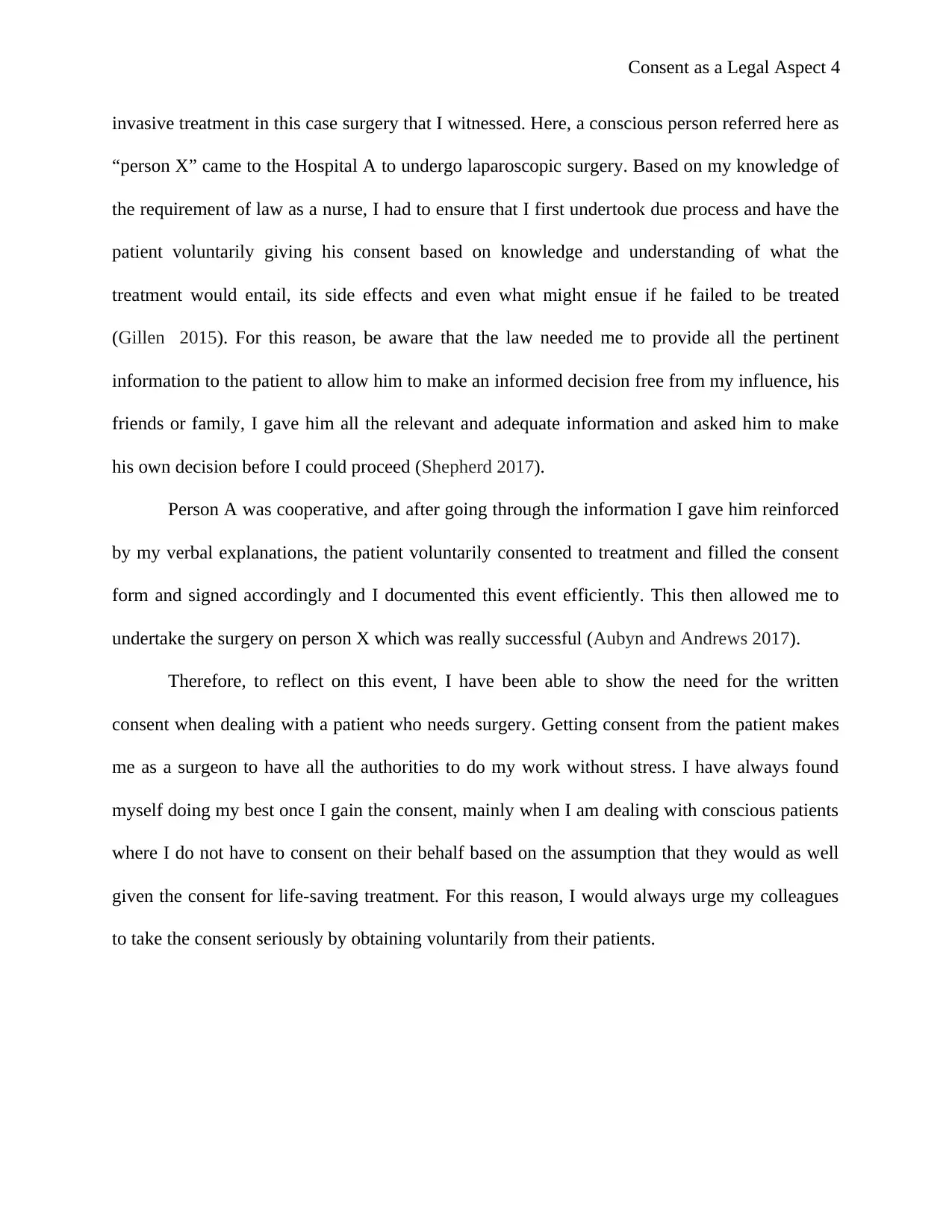
Consent as a Legal Aspect 4
invasive treatment in this case surgery that I witnessed. Here, a conscious person referred here as
“person X” came to the Hospital A to undergo laparoscopic surgery. Based on my knowledge of
the requirement of law as a nurse, I had to ensure that I first undertook due process and have the
patient voluntarily giving his consent based on knowledge and understanding of what the
treatment would entail, its side effects and even what might ensue if he failed to be treated
(Gillen 2015). For this reason, be aware that the law needed me to provide all the pertinent
information to the patient to allow him to make an informed decision free from my influence, his
friends or family, I gave him all the relevant and adequate information and asked him to make
his own decision before I could proceed (Shepherd 2017).
Person A was cooperative, and after going through the information I gave him reinforced
by my verbal explanations, the patient voluntarily consented to treatment and filled the consent
form and signed accordingly and I documented this event efficiently. This then allowed me to
undertake the surgery on person X which was really successful (Aubyn and Andrews 2017).
Therefore, to reflect on this event, I have been able to show the need for the written
consent when dealing with a patient who needs surgery. Getting consent from the patient makes
me as a surgeon to have all the authorities to do my work without stress. I have always found
myself doing my best once I gain the consent, mainly when I am dealing with conscious patients
where I do not have to consent on their behalf based on the assumption that they would as well
given the consent for life-saving treatment. For this reason, I would always urge my colleagues
to take the consent seriously by obtaining voluntarily from their patients.
invasive treatment in this case surgery that I witnessed. Here, a conscious person referred here as
“person X” came to the Hospital A to undergo laparoscopic surgery. Based on my knowledge of
the requirement of law as a nurse, I had to ensure that I first undertook due process and have the
patient voluntarily giving his consent based on knowledge and understanding of what the
treatment would entail, its side effects and even what might ensue if he failed to be treated
(Gillen 2015). For this reason, be aware that the law needed me to provide all the pertinent
information to the patient to allow him to make an informed decision free from my influence, his
friends or family, I gave him all the relevant and adequate information and asked him to make
his own decision before I could proceed (Shepherd 2017).
Person A was cooperative, and after going through the information I gave him reinforced
by my verbal explanations, the patient voluntarily consented to treatment and filled the consent
form and signed accordingly and I documented this event efficiently. This then allowed me to
undertake the surgery on person X which was really successful (Aubyn and Andrews 2017).
Therefore, to reflect on this event, I have been able to show the need for the written
consent when dealing with a patient who needs surgery. Getting consent from the patient makes
me as a surgeon to have all the authorities to do my work without stress. I have always found
myself doing my best once I gain the consent, mainly when I am dealing with conscious patients
where I do not have to consent on their behalf based on the assumption that they would as well
given the consent for life-saving treatment. For this reason, I would always urge my colleagues
to take the consent seriously by obtaining voluntarily from their patients.
Paraphrase This Document
Need a fresh take? Get an instant paraphrase of this document with our AI Paraphraser
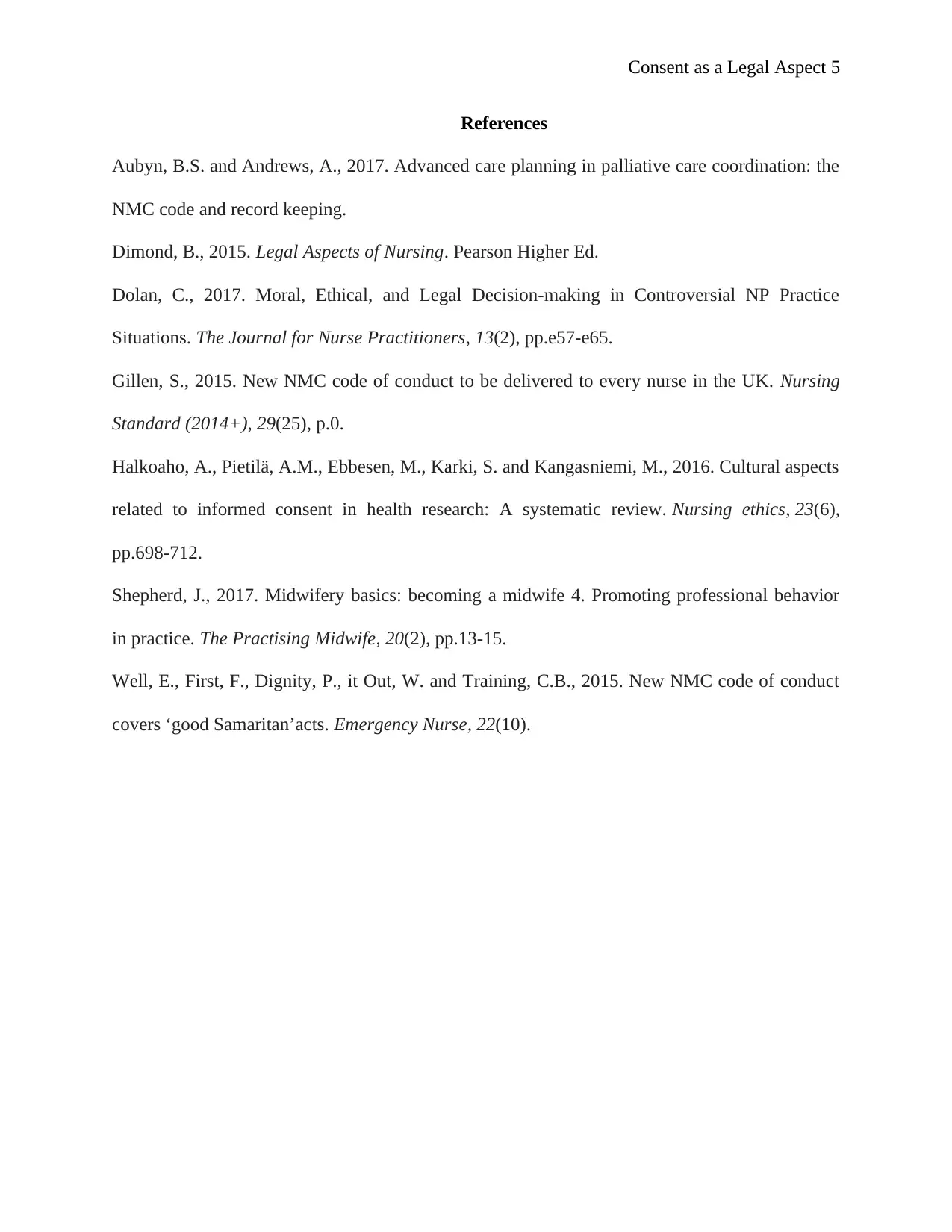
Consent as a Legal Aspect 5
References
Aubyn, B.S. and Andrews, A., 2017. Advanced care planning in palliative care coordination: the
NMC code and record keeping.
Dimond, B., 2015. Legal Aspects of Nursing. Pearson Higher Ed.
Dolan, C., 2017. Moral, Ethical, and Legal Decision-making in Controversial NP Practice
Situations. The Journal for Nurse Practitioners, 13(2), pp.e57-e65.
Gillen, S., 2015. New NMC code of conduct to be delivered to every nurse in the UK. Nursing
Standard (2014+), 29(25), p.0.
Halkoaho, A., Pietilä, A.M., Ebbesen, M., Karki, S. and Kangasniemi, M., 2016. Cultural aspects
related to informed consent in health research: A systematic review. Nursing ethics, 23(6),
pp.698-712.
Shepherd, J., 2017. Midwifery basics: becoming a midwife 4. Promoting professional behavior
in practice. The Practising Midwife, 20(2), pp.13-15.
Well, E., First, F., Dignity, P., it Out, W. and Training, C.B., 2015. New NMC code of conduct
covers ‘good Samaritan’acts. Emergency Nurse, 22(10).
References
Aubyn, B.S. and Andrews, A., 2017. Advanced care planning in palliative care coordination: the
NMC code and record keeping.
Dimond, B., 2015. Legal Aspects of Nursing. Pearson Higher Ed.
Dolan, C., 2017. Moral, Ethical, and Legal Decision-making in Controversial NP Practice
Situations. The Journal for Nurse Practitioners, 13(2), pp.e57-e65.
Gillen, S., 2015. New NMC code of conduct to be delivered to every nurse in the UK. Nursing
Standard (2014+), 29(25), p.0.
Halkoaho, A., Pietilä, A.M., Ebbesen, M., Karki, S. and Kangasniemi, M., 2016. Cultural aspects
related to informed consent in health research: A systematic review. Nursing ethics, 23(6),
pp.698-712.
Shepherd, J., 2017. Midwifery basics: becoming a midwife 4. Promoting professional behavior
in practice. The Practising Midwife, 20(2), pp.13-15.
Well, E., First, F., Dignity, P., it Out, W. and Training, C.B., 2015. New NMC code of conduct
covers ‘good Samaritan’acts. Emergency Nurse, 22(10).
1 out of 5
Related Documents
Your All-in-One AI-Powered Toolkit for Academic Success.
+13062052269
info@desklib.com
Available 24*7 on WhatsApp / Email
![[object Object]](/_next/static/media/star-bottom.7253800d.svg)
Unlock your academic potential
Copyright © 2020–2025 A2Z Services. All Rights Reserved. Developed and managed by ZUCOL.





